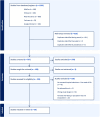Opportunities for Telemedicine to Improve Parents' Well-Being During the Neonatal Care Journey: Scoping Review
- PMID: 39622079
- PMCID: PMC11627525
- DOI: 10.2196/60610
Opportunities for Telemedicine to Improve Parents' Well-Being During the Neonatal Care Journey: Scoping Review
Abstract
Background: Neonatal intensive care unit admissions of newborns are emotional and stressful for parents, influencing their mental and physical well-being and resulting in high rates of psychological morbidities. Significant research has been undertaken to understand and quantify the burden of a newborn's medical journey on parents' well-being. Simultaneously, an increase has been observed in the development and implementation of telemedicine interventions, defined as the remote delivery of health care. Telemedicine is used as an overarching term for different technological interventions grouped as real-time audio-visual communication, remote patient monitoring, and asynchronous communication. Various telemedicine interventions have been proposed and developed but scarcely with the primary goal of improving parental well-being during their newborn's medical journey.
Objective: This study aims to identify telemedicine interventions with the potential to improve parents' well-being and to present the methods used to measure their experience.
Methods: A scoping review was conducted, including empirical studies evaluating telemedicine in neonatal care that either measured parental well-being or included parents in the evaluation. Abstract and title screening, full-text screening, and data extraction were performed by three researchers. Two researchers were needed to reach decisions on both the inclusion and extraction of articles.
Results: The review included 50 out of 737 screened articles. Telemedicine interventions focused mainly on daily visits at the neonatal intensive care unit and discharge preparedness for parents. Surveys were the primary tool used for outcome measurement (36/50, 72%). Aspects of parents' well-being were evaluated in 62% (31/50) of studies. Telemedicine interventions developed to provide education and support showed a potential to improve self-efficacy and discharge preparedness and decrease anxiety and stress when they included a real-time telemedicine component.
Conclusions: This scoping review identified specific telemedicine interventions, such as real-time audio-visual communication and eHealth apps, that have the potential to improve parental well-being by enhancing self-efficacy and discharge preparedness, and reducing anxiety and stress. However, more insights are needed to understand how these interventions affect well-being. Parents should be included in future research in both the development and evaluation stages. It is important to not only measure parents' perceptions but also focus on the impact of a telemedicine intervention on their well-being.
Keywords: NICU; family-centered care; neonatal care; neonatal intensive care unit; neonates; newborns; parental well-being; parents; pediatrics; telehealth; telemedicine.
© Josephine Wagenaar, Crystal Mah, Fredrik Bodell, Irwin Reiss, Maaike Kleinsmann, Sylvia Obermann-Borst, H Rob Taal. Originally published in JMIR Pediatrics and Parenting (https://pediatrics.jmir.org).
Conflict of interest statement
Figures



Similar articles
-
Parents' experiences of transition when their infants are discharged from the Neonatal Intensive Care Unit: a systematic review protocol.JBI Database System Rev Implement Rep. 2015 Oct;13(10):123-32. doi: 10.11124/jbisrir-2015-2287. JBI Database System Rev Implement Rep. 2015. PMID: 26571288
-
Beyond the black stump: rapid reviews of health research issues affecting regional, rural and remote Australia.Med J Aust. 2020 Dec;213 Suppl 11:S3-S32.e1. doi: 10.5694/mja2.50881. Med J Aust. 2020. PMID: 33314144
-
Implementing Evidence-Informed Discharge Preparedness Tools in the NICU: Parents' Perceptions.Adv Neonatal Care. 2021 Oct 1;21(5):E111-E119. doi: 10.1097/ANC.0000000000000836. Adv Neonatal Care. 2021. PMID: 33538497
-
Establishing a Working Definition of User Experience for eHealth Interventions of Self-reported User Experience Measures With eHealth Researchers and Adolescents: Scoping Review.J Med Internet Res. 2021 Dec 2;23(12):e25012. doi: 10.2196/25012. J Med Internet Res. 2021. PMID: 34860671 Free PMC article.
-
Impact of Parent-Targeted eHealth on Parent and Infant Health Outcomes: A Scoping Review.J Perinat Neonatal Nurs. 2017 Oct/Dec;31(4):332-340. doi: 10.1097/JPN.0000000000000265. J Perinat Neonatal Nurs. 2017. PMID: 28621700
Cited by
-
Implementation and effectiveness of Teleneonatology for neonatal intensive care unit consultations in the Netherlands: a hybrid type III implementation pilot.BMC Pediatr. 2025 Jul 29;25(1):574. doi: 10.1186/s12887-025-05923-y. BMC Pediatr. 2025. PMID: 40731275 Free PMC article.
References
-
- Geller PA, Bonacquisti A, Patterson CA. In: Motherhood in the Face of Trauma: Pathways Towards Healing and Growth. Muzik M, Rosenblum KL, editors. Springer International Publishing; 2018. Maternal experience of neonatal intensive care unit hospitalization: trauma exposure and psychosocial responses; pp. 227–247. doi. - DOI
Publication types
LinkOut - more resources
Full Text Sources

